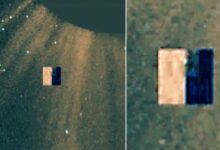Experts Can’t Explain These Titanic Images Found in 2025
A revolutionary digital scan has brought the Titanic back to life in astonishing detail, offering fresh perspectives on its tragic fate. Resting 12,000 feet beneath the Atlantic, the ship appears frozen in time, as if it sank yesterday. Declared unsinkable, Titanic disappeared on April 14, 1912, taking over 1,500 lives. For decades, researchers relied on survivor testimonies and sporadic deep-sea dives, but photogrammetry—turning thousands of images into an accurate 3D model—has now revealed secrets long hidden.
In 2022, Atlantic Productions and the deep-sea mapping firm Magellan deployed robotic explorers, capturing more than 715,000 high-resolution photographs of the wreck. By 2024, an additional 2 million images refined the model. Using advanced software, these images were stitched into a millimeter-precise virtual replica, revealing rivets, the number “401” on a propeller, and personal belongings scattered across the debris. Unlike the blurry sonar surveys of 1985, this new digital reconstruction clarifies the ship’s condition, debunks myths like the Titanic-Olympic swap theory, and tracks progressive decay, including collapsing stern sections and missing railings.
Photogrammetry is non-invasive, preserving the wreck’s sanctity while allowing historians and engineers to study it, unlike controversial salvage operations. Highlighted in National Geographic’s Titanic: The Digital Resurrection, this virtual scan serves as a forensic tool, letting experts like historian Parks Stephenson trace how the ship fractured and where chaos erupted.
The Bow: A Glimpse of 1912
The bow rises upright from the ocean depths, remarkably preserved. Thick steel plates and teak deck planks endure, while rivets and iron studs mark where softer pine decayed. The anchor remains lodged, showing the bow’s controlled descent as water filled the forward compartments. A tear near the keel marks the impact point with the seafloor, accelerating corrosion. Untouched by the stern’s violent destruction, the bow evokes 1912: crew on deck, passengers leaning on railings, oblivious to the coming disaster.
Boat Deck: Courage Amid Chaos
The boat deck tells the story of human courage and frantic evacuation. The 2022 scans reveal rusted steel plating, broken lifeboat davits, and surviving bronze winches and ventilators. Damage from falling structures, such as the second funnel, hastens decay. The collapsed grand staircase, once crowned with a glass dome, exposes ruined cabins, while missing railings underscore the wreck’s ongoing deterioration. The arrangement of lifeboats and equipment reveals orderly evacuations, contrasting with cinematic depictions of complete chaos.
A-Deck Promenade: Luxury Undone
Once a haven for first-class passengers, the A-Deck promenade is now a crumpled ruin. Scans show collapsed beams, corroded steel partitions, and cabin walls melding with the seafloor. Being near the breakup point caused a “layered collapse”, speeding decay. Despite the damage, the layout hints at former elegance, where passengers such as John Jacob Astor once strolled, unaware of impending tragedy.
Breakup Point: The Ship Fractures
The site of Titanic’s final split is a chaotic wound. Decks are crushed, steel twisted, and corrosion rampant. Scans indicate a low-angle fracture, as water flooded six compartments—beyond the ship’s four-compartment design limit. Edges of steel curl like burnt paper, capturing the moment of catastrophic failure in vivid detail.
Stern: Evidence of Violence
The stern, located 600 meters from the bow, is a mangled testament to the plunge. Smashed decks, peeled hull plates, and a curled poop deck dominate the scene. Some features, like the second-class entrance and elevator mechanisms, remain, but most of the stern is rapidly decaying, reflecting the implosion of air-filled compartments, a stark contrast to the bow’s calm.
Artifacts: Human Stories Preserved
Personal belongings bring the tragedy to life:
-
A purse belonging to third-class passenger Marian Meanwell, containing her medical card.
-
The Diana of Versailles statue from the first-class lounge.
-
Scattered jewelry, shoes, and pocket watches.
Digitally preserved, these items allow future generations to connect with passengers’ lives, from third-class immigrants to first-class elites.
Engineers’ Sacrifice
In Boiler Room 2, engineers kept the generators running as water flooded the ship, ensuring lights remained on for lifeboat launches. Warped steel plates and open valves show their heroic work. All 25 engineers perished, and their workspace now stands as a digital memorial to their bravery.
Final Hours Reimagined
The scans offer a clearer timeline of Titanic’s last moments:
-
The bow’s gentle tilt suggests gradual, even flooding.
-
Davit positions indicate organized lifeboat launches.
-
Electrical fittings near the grand staircase remained intact after the split, reflecting the engineers’ efforts.
Measured and detailed, these digital insights replace guesswork with hard evidence of courage and tragedy.
A Race Against Time
Although the ship’s depth slows decay, Titanic continues to deteriorate. Within 50 years, only thick steel ribs may remain, resembling a massive whale skeleton. This digital time capsule ensures future generations can explore the wreck before it is claimed entirely by the ocean.
Conclusion
The Digital Titanic is more than a virtual museum—it is a scientific tool, historical archive, and memorial, preserving the intricate story of Titanic’s final hours, from structural details and personal artifacts to human heroism and tragedy.




